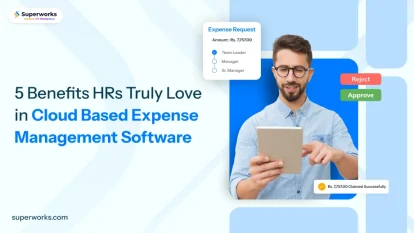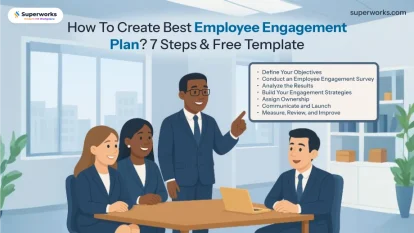Grab a chance to avail 6 Months of Performance Module for FREE
Book a free demo session & learn more about it!
-
Will customized solution for your needs
-
Empowering users with user-friendly features
-
Driving success across diverse industries, everywhere.
Grab a chance to avail 6 Months of Performance Module for FREE
Book a free demo session & learn more about it!
Superworks
Modern HR Workplace
Your Partner in the entire Employee Life Cycle
From recruitment to retirement manage every stage of employee lifecycle with ease.


Seamless onboarding & offboarding
Automated compliance & payroll
Track performance & engagement
Employee Performance Appraisal: A Step-to-Step Guide You’ve Been Searching For!
- Performance Appraisal
- 9 min read
- October 19, 2023

Even Chandrayan 3 has landed on the moon, what still remains a difficult task is how companies increase their team’s efficiency.
Jokes apart– a good number of HR managers out there are just trying hard even today to keep the employees happy so that they will put their best foot forward.
Are you one of those HRs? If yes, let us tell you are just at the right place!
In this blog, we will tell you how employee performance appraisal can help you keep your employees efficient along the way.
So, shall we start?
- What is a Performance Appraisal Process?
- Top 5 Benefits of Performance Appraisals
- Step-to-Step Guide of the Employee Performance Appraisal Process
- 5 Mistakes to Avoid For an Effective Performance Appraisal Process
- Bottom Line
What is a Performance Appraisal Process?
The performance appraisal process, which is also named a performance review or performance evaluation, is a process of monitoring and evaluating employees’ performance in a particular time period.
This process mainly helps employers and organizations to get a clear picture of the strengths, weaknesses, and achievements of their employees. It also helps them identify the areas where every employee may need improvement to grow and flourish in the long run.
Needless to say, the employee performance appraisal process is definitely a great tool to maintain employee engagement across the workplace.
So, the question here is why is this policy necessary? Well, it helps companies to give fair promotions and increments to every employee, which is again very important for systematic human resource management.
To Read More : Solve Workforce Puzzle With Workforce Management Software!
Top 5 Benefits of Performance Appraisals
Performance appraisals offer a multitude of benefits for both employees and employers alike.
Take a look at the top five ones you must know:
– Enhanced Employee Performance:
So, the first benefit of performance appraisals is it improves employee performance like never before. Thinking how? Well, appraisals ensure that there is a fixed communication channel for managers and their peers. This communication channel allows them to discuss issues, address them together, set goals, and much more.
In such a manner, employees will always know what are the areas they are excelling and what are the areas that need to be improved.
This, in turn, helps employees to address their shortcomings promptly and focus on the right tasks.
So, the performance appraisal process empowers employees to reach their best selves which can help businesses stay ahead of the curve.
– Goal Alignment:
Another best thing about a performance appraisal is that it allows the alignment of an employee’s goals with the objective and vision of the company.
You may know that a lot of new goals are made throughout the appraisal process. By setting such clear goals, employees get a better view of their role in the company’s success. As a result, employees and the company move in the same direction, hand-in-hand.
So, performance appraisals are great when it comes to promoting a sense of purpose among employees, which is extremely vital for the growth of any business, be it small, medium-sized, or large.
– Personal and Professional Development:
Employees love it when they are given ample opportunities to grow and upskill professionally. When we talk about personal development, how can we forget the performance appraisal process?
As we already mentioned, the process is the best tool to identify the improvement areas that can help an employee to keep learning along the way
By encouraging employees’ strengths with fair appraisals, the process also helps employees feel confident and motivates them to reach their maximum potential henceforth.
So, employee performance appraisals are not just an evaluation tool but also a ladder for improvement and growth for employees at every level.
– Feedback and Recognition:
Performance appraisals also make way for continuous feedback as well as fair recognition, which are two integral factors that lead to 5X engaged, satisfied, and happier workforces.
Never overlook the power of constructive feedback. Try to give as much constructive feedback as possible during the appraisal process. It should be given in a way that their hard work is acknowledged and at the same time, they are guided towards places where they need to improve their performance.
Giving feedback is, undoubtedly, an art. But, if you crack this art, the appraisal process can be seamless and will definitely bring you incredible results in the times ahead.
– Data-Driven Decision Making:
Through the appraisal process, companies can even get their hands on some realistic and real-time data that can further help them to make smart decisions.
People also use technologies like HRMS software to retrieve real-time and accurate performance data. With software such as Superworks, managers and HRs can get the performance graph of an employee in just a tap.
So, with the help of technology and the right strategy, the employee performance appraisal can be more data-driven.
When employees are given unbiased increments and are put in the right position using the data, they will never question the company and will go the extra mile for them.

Want to streamline your business operations once and for all?
Try Superworks HRMS software today to transform all your crucial business & HR operations in just a few clicks. With Superworks, you will save time, boost employee efficiency, improve employee engagement, and much more.
Make a new difference with our user-friendly and efficient HRMS software!
Step-to-Step Guide of the Employee Performance Appraisal Process
Now that you know the meaning and why a performance appraisal is important, it is time to explore how you can carry out it in the most effective way.
1. Goal Setting:
Establish Clear Expectations:
Discuss and set clear performance expectations with the employee. Ensure that both parties understand the job requirements, goals, and objectives.
Set SMART Goals:
Help the employee set Specific, Measurable, Achievable, Relevant, and Time-bound (SMART) goals for the coming appraisal period.
2. Appraisal Meeting Schedule:
Set a Date:
Schedule a specific date and time for the performance appraisal meeting. Ensure it is well in advance, allowing both the appraiser and the employee time to prepare.
Inform the Employee:
Notify the employee of the appraisal meeting and provide them with any necessary forms or documents to complete before the meeting.
3. Self-Assessment (Optional):
Some organizations include a self-assessment phase, where employees reflect on their performance and achievements, and set goals for improvement. This can be done through a self-assessment form or document.
4. Conducting the Appraisal Meeting:
Discuss Performance:
During the meeting, the appraiser and employee should discuss the employee’s performance, strengths, weaknesses, achievements, and areas for improvement.
Provide Feedback
Give specific and constructive feedback. Utilize examples to explain your points as well as avoid generalizations.
Set New Goals:
Set performance goals for the next appraisal period. Make sure these are aligned with the organization’s goals and the employee’s career development.
Discuss Development:
Talk about training and development opportunities that can help the employee improve their performance.
Listen and Address Concerns:
Allow the employee to share their thoughts, concerns, or ideas. Do not forget to address any doubts, queries, or issues they may have.
Save the Discussion:
By saving the discussion, we mean you should document all the important pointers you talked about, such as the goals you set, the plan for the next cycle, and much more.
5. Appraisal Form and Rating:
Complete the performance appraisal form or document, providing ratings and comments for different performance criteria. Ensure the ratings are fair and objective, based on the established performance criteria.
6. Follow-Up Actions:
After the meeting, both the appraiser and the employee should work together to achieve the set goals and address any areas for improvement. Monitor progress throughout the appraisal period, providing regular feedback and support.
7. Review and Approval:
If necessary, the performance appraisal may go through a review process involving higher-level management to ensure fairness and consistency.
8. Communication:
The appraiser communicates the final appraisal results and feedback to the employee. Positive recognition and rewards can be given for exceptional performance.
9. Documentation:
Keep a record of the appraisal for future reference and for use in subsequent appraisals.
10. Feedback and Improvement:
Encourage the employee to provide feedback on the appraisal process to help improve it in the future.
11. Follow-Up and Next Appraisal:
Use the performance appraisal as a tool for ongoing performance improvement and career development—plan for the next appraisal cycle.
5 Mistakes to Avoid For an Effective Performance Appraisal Process
Lack of Clear Communication:
One of the most critical aspects of a performance appraisal is clear and open communication. Failing to establish a transparent channel of communication can lead to misunderstandings, decreased employee morale, and resistance to feedback. To avoid this mistake, ensure that expectations, criteria, and feedback are communicated clearly and regularly throughout the year. You can invest in one of the HRMS software or performance management software such as Superworks to ensure transparency throughout employee performance appraisal of employees.
Focusing Only on Negatives:
Many organizations make the mistake of solely highlighting an employee’s weaknesses during performance appraisals. This can be demotivating and counterproductive. Instead, balance the feedback by recognizing and appreciating an employee’s strengths and accomplishments. Discuss areas for improvement constructively, providing opportunities for growth.
Inconsistent Feedback:
Consistency is key in the performance appraisal process. Providing inconsistent feedback from one appraisal to the next can result in confusion and mistrust among employees.
To prevent this, establish standardized evaluation criteria and ensure that all employees are assessed against the same benchmarks.
Ignoring Employee Input:
Employees often have valuable insights into their own performance and development needs. Neglecting the input of an employee in the appraisal process is a common mistake.
Encourage employees to self-assess, set goals, and provide feedback on their performance. This participatory approach can lead to more meaningful appraisals and higher engagement.
Neglecting Development Planning:
The performance appraisal process should not end with feedback; it should include a focus on development and growth.
A common mistake is failing to create a clear and actionable development plan for employees based on their appraisal results. Ensure that employees have a roadmap for improvement, and follow up on these plans throughout the year to track progress.
Bottom Line
In conclusion, employee performance reviews and performance appraisals can be indispensable tools for fostering growth and productivity in any organization.
With this step-by-step guide at your disposal, you now have the key to unlocking the full potential of your workforce. By following these systematic steps, you can not only evaluate employee performance but also nurture a culture of continuous improvement, development, and improved employee engagement.
Embrace the power of performance appraisals and watch your team flourish, taking your organization to new heights of success.
Also Read: hr outsourcing services | Employee recognition







